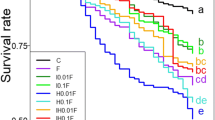Abstract
Honey bee (Apis mellifera carnica) colonies were placed in two apple orchards treated with the insecticides diazinon and thiacloprid and the fungicide difenoconazole in accordance with a Protection Treatment Plan in the spring of 2007. Pollen and bee bread were collected from combs inside the hives. The residue of diazinon in pollen loads 10 days after orchard treatment was 0.09 mg/kg, and the same amount of residue was found in bee bread 16 days after treatment. In pollen loads 6 days after application 0.03 mg/kg of thiacloprid residues and 0.01 mg/kg of difenoconazole were found on the first day after application. Possible sub-lethal effects on individual honey bees and brood are discussed.
Similar content being viewed by others
References
Bonmatin JM, Moineau I, Charvet R, Fléché C, Colin ME, Bengsch ER (2003) A LC/APCIMS/MS method for analysis of imidacloprid in soils, in plants, and in pollens. Anal Chem 75:2027–2033. doi:10.1021/ac020600b
Bossi R, Vejrup KV, Mogensen BB, Asman WAH (2002) Analysis of polar pesticides in rainwater in Denmark by liquid chromatography-tandem mass spectrometry. J Chromatogr A 957:27–36. doi:10.1016/S0021-9673(02)00312-6
Chauzat MP, Faucon JP, Martel AC, Lachaize J, Cougoule N, Aubert M (2006) A survey of pesticide residues in pollen loads collected by honey bees in France. J Econ Entomol 99:253–262
Fillion J, Sauve F, Selwyn J (2000) Multiresidue method for the determination of residues of 251 pesticides in fruit and vegetables by gas chromatography/mass spectrometry and liquid chromatography with fluorescence detection. J AOAC Int 83:698–712
FOOTPRINT (2007) The FOOTPRINT pesticide properties database. Database collated by the University of Hertfordshire as part of the EU-funded FOOTPRINT project (FP6-SSP-022704). http://www.eu-footprint.org/ppdb.html of subordinate document. Accessed 15 Jan 2008
Gregorc A, Bowen ID (2000) The histochemical characterisation of cell death in honeybee larvae midgut after treatment with Paenibacillus larvae, Amitraz and Oxytetracycline. Cell Biol Int 24:319–324. doi:10.1006/cbir.1999.0490
Gregorc A, Smodiš Škerl MI (2007) Toxicological and immunohistochemical testing of honey bees after oxalic acid and rotenone treatments. Apidologie 38:296–305. doi:10.1051/apido:2007014
Gregorc A, Pogacnik A, Bowen ID (2004) Cell death in honey bee (Apis mellifera) larvae treated with oxalic or formic acid. Apidologie 35:453–460. doi:10.1051/apido:2004037
Kevan PG (1999) Pollinators as bioindicators of the state of the environment: species, activity and diversity. Agric Ecosyst Environ 74:373–393. doi:10.1016/S0167-8809(99)00044-4
Koch H, Weisser P (1997) Exposure of honey bees during pesticide application under field conditions. Apidologie 28:439–447. doi:10.1051/apido:19970610
Makovi CM, McMahon BM, FDA (ur.) (1999) Pesticide analytical manual, vol 1, Extraction with acetone, liquid–liquid partitioning with petroleum ether/methylene chloride. R.O.W. Sciences, Inc., 302–307
McKenzie KE, Winston ML (1989) Effects of sublethal exposure to diazinon on longevity and temporal division of labor in the honey bee (Hymenoptera: Apidae). J Econ Entomol 82:75–82
Papaefthimiou C, Pavlidou V, Gregorc A, Theophilidis G (2002) The action of 2, 4-dichlorophenoxyacetic acid on the isolated heart of insect and amphibia. Environ Toxicol Pharmacol 11:127–140. doi:10.1016/S1382-6689(01)00113-2
Porrini C, Sabatini AG, Girotti S, Fini F, Monaco L, Celli G, Bartolotti L, Ghini S (2003) The death of honey bees and environmental pollution by pesticides: the honey bees as biological indicators. Bull Insectol 56:147–152
Rortais A, Arnold G, Halm MP, Touffet-Briens F (2005) Modes of honey bee exposure to systemic insecticides: estimated amounts of contaminated pollen and nectar consumed by different categories of bees. Apidologie 36:71–83. doi:10.1051/apido:2004071
Rosiak KL (2002) The effects of two polychlorinated biphenyl mixtures on honey bee (Apis mellifera) foraging and hypopharyngeal gland development. Dissertation, Urbana, Illinois
Russel D, Meyer R, Bukowski J (1998) Potential impact of microencapsulated pesticides on New Jersey apiaries. Am Bee J 138:207–210
Schmuck R, Schöning R, Stork A, Schramel O (2001) Risk posed to honey bees (Apis mellifera L. Hymenoptera) by an imidacloprid seed dressing of sunflowers. Pest Manage Sci 57:225–238. doi:10.1002/ps.270
Silva-Zacarin ECM, Gregorc A, Silva de Moraes RLM (2006) In situ localization of heat-shock proteins and cell death labelling in the salivary gland of acaricide-treated honey bee larvae. Apidologie 37:507–516. doi:10.1051/apido:2006030
Thier HP, Zeumer H, DFG (ur.) (1987) Manual of pesticide residue analysis, vol 1, organochlorine, organophosphorus, nitrogen-containing and other pesticides. Weinheim, VCH, Verlagsgesellschaft, 383–400
Thier HP, Zeumer H, DFG (ur.) (1992) Manual of pesticide residue analysis, vol 2, cleanup method 6. Weinheim, VCH, Verlagsgesellschaft, 31–36
Thompson HM, Hunt LV (1999) Extrapolating from honey bees to bumble bees in pesticide risk assessment. Ecotoxicology 8:147–166. doi:10.1023/A:1026444029579
Villa S, Vighi M, Finizio A, Bolchi Serini G (2000) Risk assessment for honey bees from pesticide-exposed pollen. Ecotoxicology 9:287–297. doi:10.1023/A:1026522112328
Waller GD, Erickson BJ, Harvey J, Martin JH (1984) Effects of dimethoate on honey bees (Hymenoptera: Apidae) when applied to flowering lemons. J Econ Entomol 77:70–74
Weick J, Thorn RS (2002) Effects of acute sublethal exposure to coumaphos or diazinon on acquisition and discrimination of odour stimuli in the honey bee (Hymenoptera: Apidae). J Econ Entomol 95:227–236
Acknowledgments
We would like to thank to Roman Mavec and Janez Markuta, heads of the experimental orchards at Brdo and Čadovlje for their collaboration which made the experiments possible. Thanks are also due to Marjan Kokalj for his technical assistance and help in collecting samples. This study was funded by the Slovenian Research Agency, Project Number L7-7602 and V4-0484.
Author information
Authors and Affiliations
Corresponding author
Rights and permissions
About this article
Cite this article
Smodiš Škerl, M.I., Velikonja Bolta, Š., Baša Česnik, H. et al. Residues of Pesticides in Honeybee (Apis mellifera carnica) Bee Bread and in Pollen Loads from Treated Apple Orchards. Bull Environ Contam Toxicol 83, 374–377 (2009). https://doi.org/10.1007/s00128-009-9762-0
Received:
Accepted:
Published:
Issue Date:
DOI: https://doi.org/10.1007/s00128-009-9762-0




